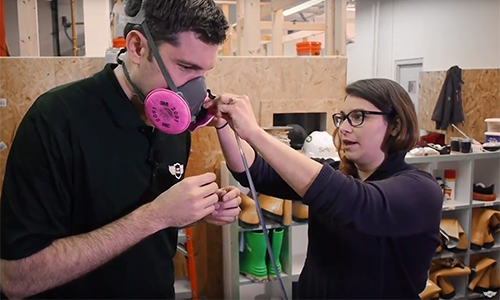Respirator Fit Testing Requirements & Demo – On the Job Safety Tips with SAFEX
One of the most common topics for safety questions and concerns we hear about is respirator use and what is required for fit testing. Certainly breathing in dangerous materials is a big concern for safety and an area OSHA has a lot of focus (Respiratory Protection Standard 29 CFR 1910.134). You can find yourself with serious fines if not properly addressed and that’ll only increase with the impending OSHA Silica Rules 9/23/17. To get a better understanding for ourselves we have again asked out friends at SAFEX for some assistance to understand more about respirators, fit testing, who is required to get them and what is involved in doing the tests.
There are 2 types of fit tests which we go through in the video:
Quantitative Fit Testing – fit testing using specific equipment (like the TSI PortaCount) to measure leakage into the breathing zone of the respirator face piece.
Qualitative Fit Testing – fit testing uses a challenge agent such as banana oil, saccharin, or Bitrex. The test is subjective and relies on the worker’s sense of taste or smell.
Facial hair is possibly the biggest issue with respirator use, whether it be due to simply not having shaved or push back to keeping facial hair the rule is pretty clear, no facial hair for the test or use thereafter period. If you just found this article after googling ways to keep that awesome Fu Manchu while using a respirator unfortunately we have no good news for you… it’s got to go.
Another big requirement that we don’t hear much about is medical clearance, before an employee is fit-tested or required to use a respirator in the work place, you must have a medical evaluation to determine if the employee is even able to use the respirator. This may not involve an actual doctor’s visit but must go through a medical professional and is an important step.
For the new OSHA Silica Standards there are several applications in Table 1 that require respirators even with controlled dust collection such as concrete grinding indoors or other highly silica dust generating applications. Certainly Table 1 is very cautious which it should be and for larger companies it will probably make sense to also do a Silica Assessment for employees to see what actual exposure levels are, with proper data other engineered controls might be possible.
Hopefully what is clear is any time a job requires respirators you should consult a safety professional such as Safex or someone equally qualified in your region. There are any number of issues that could arise with OSHA fines and employee safety, that are very serious. Even for one man operations safety companies offer fit testing you can do without an appointment.


There are certainly a whole lot of particulars like that to take into consideration. That is a great point to bring up. I provide the ideas above as normal inspiration however clearly there are questions like the one you carry up the place a very powerful factor can be working in sincere good faith. I don?t know if greatest practices have emerged around issues like that, but I am certain that your job is clearly identified as a good game. Both girls and boys really feel the influence of just a second’s pleasure, for the remainder of their lives.
Hmm it appears like your website ate my first comment (it was extremely long) so I guess I’ll just sum it up what I submitted and say, I’m thoroughly enjoying your blog. I as well am an aspiring blog blogger but I’m still new to everything. Do you have any points for first-time blog writers? I’d definitely appreciate it.